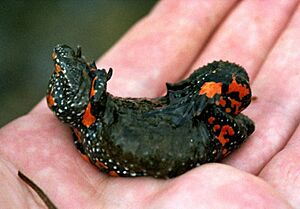European fire-bellied toad facts for kids
Quick facts for kids European fire-bellied toad |
|
|---|---|
 |
|
| Conservation status | |
| Scientific classification | |
| Genus: |
Bombina
|
| Species: |
bombina
|
 |
|
| Synonyms | |
|
List
|
|
The European fire-bellied toad (Bombina bombina) is a type of fire-bellied toad found in eastern Europe. It lives near water, like ponds and marshes. This toad is famous for its bright red belly, which it uses to scare away animals that might want to eat it. This warning color is called aposematism. It also has a special "whoop" call.
Contents
About the European Fire-Bellied Toad
The European fire-bellied toad is a medium-sized frog. It can grow to about 5.6 centimetres (2+3⁄16 in) long. Its back can be gray, brown, or green. But its belly is bright red with thick black spots. The backs of these frogs are also covered in small bumps, like warts.
When a predator threatens it, the fire-bellied toad will lift its arms and sometimes even flip over. This shows off its bright red belly. This color warns the predator that the toad is poisonous. This special defense move is called Unkenreflex. It is a great example of aposematism, where an animal uses bright colors to say "stay away, I'm dangerous!"
Where These Toads Live
The European fire-bellied toad lives across Central and Eastern Europe. You can find them from eastern Germany (including parts of Denmark and southern Sweden) all the way east to the Volga District in Russia. The Ural Mountains stop them from going further east. Their most southern homes are in Bulgaria and the Marmara Region of Turkey.
There is also a group of these toads that were brought to Lorraine, France. This is over 500 kilometres (310 mi) from where they naturally live. This group was first found in 2009. It seems humans moved them there on purpose. These toads could affect the local yellow-bellied toads by mixing with them.
Even though the IUCN lists this frog as "Least Concern" (meaning it's not in immediate danger), its numbers have been dropping in some areas. For example, in Denmark, 15 groups of breeding frogs were found in 1974. But by 1988, only 8 of those groups were left. In some places, like Funen County, Denmark, people are helping them recover. They dug many new ponds for the frogs. This has helped their population grow about five times bigger in ten years!
Life and Habits of the Fire-Bellied Toad
These frogs usually live in low-lying areas. They like ponds and marshes that don't have too many trees. In bigger lakes, they stay near the edges, about 50 to 70 centimetres (20 to 28 in) deep. They hide in reed beds and floodplains.
What They Eat
European fire-bellied toads eat all kinds of small invertebrates. They especially like springtails, beetles, flies, and ants.
Who Eats Them
Many animals hunt these frogs. Snakes and birds are common predators. Younger toads, called Tadpoles, can be eaten by leeches and fish.
Hibernation and Reproduction
These toads usually go into hibernation when temperatures drop to about 4 °C (39 °F). They dig into the soil or a rotting log. They stay in a deep sleep, called torpor, until spring arrives.
Reproduction starts when the temperature reaches about 16 °C (61 °F). This usually happens at night or early morning. Female toads lay between 15 to 40 eggs, depending on their size. The Tadpoles hatch in about a week. They grow for about a month before they change into small frogs. This change is called metamorphosing. They are about 3.8 centimetres (1+1⁄2 in) long when they become frogs.
How Fire-Bellied Toads Evolved
The European fire-bellied toad (B. bombina) and the yellow-bellied toad (B. variegata) are closely related. They both came from an ancient toad ancestor. They evolved in different ways over time. This process is called divergent evolution. However, they can still breed together where their living areas overlap. This is called hybridizing.
These two toad species evolved during the Pleistocene epoch (a long time ago!). Their ancestor lived in southern Europe during the last Ice Age. The yellow-bellied toad evolved in the mountains to the west. The European fire-bellied toad evolved in the lowlands to the east, near the Black and Caspian Sea.
As the glaciers melted, both species spread across Europe. They competed and sometimes hybridized. Eventually, B. bombina settled in the lowlands. B. variegata moved to higher, mountainous areas.
Differences Between the Toads
Even though they can hybridize, these two frogs usually avoid it. They have different body shapes and behaviors. B. bombina prefers to breed in lowland seasonal ponds. These are temporary ponds in wet meadows and floodplains, but they are close to permanent water. On the other hand, B. variegata likes to breed in higher places in temporary ponds that dry up quickly.
B. bombina also spends more time in water. B. variegata spends more time on land. It has longer legs and thicker skin, which helps it move around on dry land. Also, B. variegata cannot sing as loudly as B. bombina. This is because B. variegata does not have internal vocal sacs. This difference helps them find different breeding ponds.
Special Chemicals in Their Skin
Like other fire-bellied toads, B. bombina produces special chemicals in its skin. These chemicals can help protect them from bacteria and fungi. Scientists have studied these chemicals for many years. They are even looking at how these chemicals could be used to keep food fresh!



